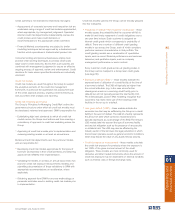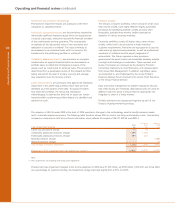RBS 2005 Annual Report Download - page 89
Download and view the complete annual report
Please find page 89 of the 2005 RBS annual report below. You can navigate through the pages in the report by either clicking on the pages listed below, or by using the keyword search tool below to find specific information within the annual report.
section
01
Operating and
financial review
87
Operating and financial review
Annual Report and Accounts 2005
Risk management
The principal risks that the Group manages are as follows:
•Credit risk: is the risk arising from the possibility that the
Group will incur losses from the failure of customers to meet
their obligations.
•Liquidity risk: is the risk that the Group is unable to meet its
obligations as they fall due.
•Market risk: the Group is exposed to market risk because of
positions held in its trading portfolios and its non-trading
businesses.
•Insurance risk: the Group is exposed to insurance risk, either directly through its businesses or through using insurance as a tool
to mitigate other risk exposures.
•Enterprise risk: the Group separately defines operational and external risk. Operational risk is defined as the risk arising from the
Group’s people, processes, systems and assets. External risk comprises business, political and environmental risk.
•Regulatory risk: is the risk arising from failing to meet the requirements and expectations of our many regulators, or from a failure
to address or implement any change in these requirements or expectations.
Risk appetite
Risk management across the Group is based on the risk
appetite and philosophy set by the Board and the associated
risk committees. The Board establishes the parameters for risk
appetite for the Group through:
•Setting strategic direction.
•Contributing to, and ultimately approving annual plans for
each division.
•Regularly reviewing and monitoring the Group’s
performance in relation to risk through monthly Board
Reports.
The Board delegates the articulation of risk appetite to
GEMC and ensures that this is in line with the strategy
and the desired risk reward trade off for the Group. Risk
appetite is an expression of the maximum level of residual
risk that the Group is prepared to accept in order to
deliver its business objectives and is assessed against
regular (often daily) controls and stress testing to ensure
that the limits are not compromised in abnormal
circumstances.
Risk appetite is usually defined in both quantitative and
qualitative terms. Whilst different techniques are used to
ensure that the Group’s risk appetite is achieved, generically
they can be classified as follows:
•Quantitative: encompassing stress testing, risk concentration, value at risk
and credit related metrics, including the probability, loss and exposure at default.
•Qualitative: focuses on ensuring that the Group applies the correct principles, policies and procedures.
The annual business planning and performance management process and associated activities ensure the expression of risk
appetite remains appropriate. GRC and GALCO support this work.
Stress testing
Concentration
EL, PD, EAD, LGD
Principles
Policies
Procedures
Procedures
Policies
Stress testing
Principles
Policies
Procedures
Risk criticality
Value at risk
Stress testing
Policies
Guidelines
Stock of
liquid assets
Mismatch limits
Stress testing
Principles
Policies
Procedures
Impact assessment
Procedures
Principles
Policies
Q
u
a
n
t
i
t
a
t
i
v
e
Q
u
a
l
i
t
a
t
i
v
e
Q
u
a
n
t
i
t
a
t
i
v
e
Q
u
a
l
i
t
a
t
i
v
e
Q
u
a
n
t
i
t
a
t
i
v
e
Q
u
a
l
i
t
a
t
i
v
e
Q
u
a
n
t
i
t
a
t
i
v
e
Q
u
a
l
i
t
a
t
i
v
e
Q
u
a
n
t
i
t
a
t
i
v
e
Q
u
a
l
i
t
a
t
i
v
e
Q
u
a
l
i
t
a
t
i
v
e
Q
u
a
n
t
i
t
a
t
i
v
e
M
a
r
k
e
t
r
i
s
k
L
i
q
u
i
d
i
t
y
r
i
s
k
R
e
g
u
l
a
t
o
r
y
r
i
s
k
E
n
t
e
r
p
r
i
s
e
r
i
s
k
I
n
s
u
r
a
n
c
e
r
i
s
k
C
r
e
d
i
t
r
i
s
k
Principal risk types
Regulatory risk
Liquidity Insurance
Credit risk risk Market risk risk
Enterprise risk
Qualitative and quantitative elements of risk management
























